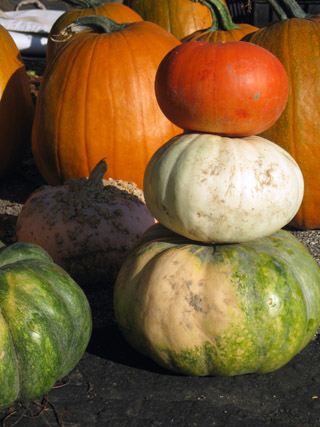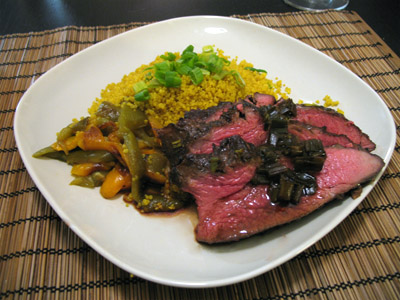Chez Ham sounds kind of like Sheahan, or at least the version of my last name most strangers use before I correct their pronunciation. So, by my poor sense of logic, it was only a matter of time before I started vandalizing Graham's blog. But, be warned, just like Sheahan doesn't sound quite as nice as Chez Ham, my ramblings won't compare with Graham's witty asides and calculated prose. Similarly, Graham is a better cook. It's true. His onions are always perfectly chopped and his béchamel comes out every time. It took me a while to get over it, but I've finally accepted my inferiority in the kitchen ... and now have a good excuse why he should chop the vegetables when we cook together.
But, I do have something that Graham no longer has: fall. When he moved to the west coast, he left all connection to the seasonality of food behind. For those of us elsewhere in the states (and beyond), it undoubtedly will be annoying when Graham continues cooking with tomatoes well into the winter. On his recent trip to Michigan, I reminded him what fall feels and looks like — from the chilly mornings, to apple cider, to the farmers markets full of pumpkins and other beautiful squash. We cooked most of our fall favorites, and I even sent him back to California with some leftovers to remind him of what the rest of us are experiencing.
So, today, I bring you fall. I am convinced it is most people's favorite season because it is here so briefly; it's the buffer between repressively humid summers and winters that never end. We soak up all of the sensory details before our canvases turn white and our farms similarly blank. I find myself coming home from the farmers market with far more squash and root vegetables than I could possibly consume in one week — I blame the constant reminder that the scarcity of winter is upon us, particularly in the frozen tundra I am currently inhabiting.
I am normally not one for baking, particularly desserts, but this apple cake has resonated with my love for autumn, cinnamon, and soggy things. Many thanks to my new friend Miriam for the lovely introduction. She shared her labor with a lucky group of us at one of our first study sessions of the semester. For some reason, we continue to invite her back — I'm not sure if it's the hope that another apple cake will accompany her, or if its her impressive grasp of math.
Apple Cake
Adapted From Edna Lewis'
"The Gift of Southern Cooking"
"The Gift of Southern Cooking"
 For the Cake
For the Cake- 1 Cup Brown sugar
- 1 Cup Granulated sugar
- 1 1/2 Cups vegetable oil
- 3 Eggs
- 3 Cups All-purpose flour
- 1 Tsp Baking soda
- 2 Tsp Cinnamon
- 1/2 Tsp Nutmeg
- 1/2 Tsp Salt
- 5 Fresh, tart apples, peeled, cored, and diced into 1/2 inch pieces
- 2 1/4 Tsp vanilla extract
For the Glaze
- 4 Tbs (1/2 stick) unsalted butter
- 1/4 Cup granulated sugar
- 1/4 Cup brown sugar
- Pinch of salt
- 1/2 Cup heavy cream
- Preheat oven to 325F
- Butter and flour 9"x13" baking pan
- Put sugars and vegetable oil in a mixing bowl, and beat until very well blended. Add the eggs one at a time, beating well after each addition. Sift together the flour, baking soda, cinnamon, nutmeg, and salt, and gradually add to the sugar and eggs, mixing just until well blended. Stir in the apples and vanilla, and pour into the prepared pan.
- Bake in the preheated oven until a skewer or toothpick inserted into the center of the cake comes out clean, about 1 1/4 hrs (begin checking after 50 minutes). Remove from the oven, and allow to cool in the pan while you prepare the glaze.
- To make the glaze, melt the butter in a saucepan, and add both the sugars and the salt. Stir until blended, a cook over medium-low heat for 2 minutes. Stir in the heavy cream, and boil for 2 minutes, stirring constantly. Remove from heat.
- Use a skewer or toothpick to poke holes all over the top of the cake,and pour the warm glaze over the surface. Serve warm, at room temperature, or the next day (if you like soggy as much as me).


